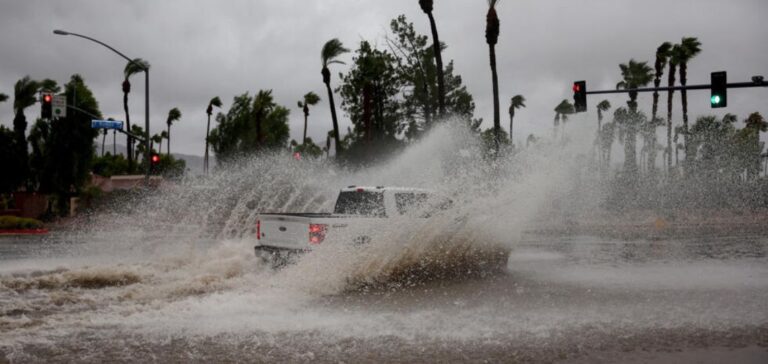California utilities are working to restore power after Tropical Storm Hilary swept through Southern California, knocking out solar production as clouds covered much of the state.
Storm Hilary hits California with record rainfall and historically low temperature changes
Hilary evolved from a hurricane to a tropical storm before making landfall on August 20 over the northern Baja California peninsula, then heading towards southern California.
“After moving into the interior of Southern California on Sunday, the moisture associated with Hilary is expected to continue to flow northward through the Intermountain West [21 août],” said the U.S. National Weather Service in its August 21 daily bulletin.
Several regions in Southern California reached new record lows on August 20, and set new daily precipitation records. Lake Cuyamaca received 4.11 inches of rain, breaking a 1984 record, while San Diego received 1.82 inches of rain, breaking a 1906 record, according to the weather service. In Palm Springs, 3.18 inches of rain fell on August 20, bringing the monthly total to 3.1 inches above normal, according to the weather service.
“We’re already back to normal weather, which will allow crews to access outage locations,” said Jeff Monford, spokesman for Southern California Edison.
Power cuts: Storm Hilary leaves nearly 500,000 customers without power in California
At the height of the blackouts, around 500,000 customers were without power, according to the electricity companies. There were more than 51,000 outages across California at 1 p.m. CT on August 21. SCE had 10,643 customers without power at 9:30am PT on August 21, compared with 380,154 on August 18, according to Monford.
The storm caused extensive wind damage in Pacific Gas and Electric’s service territory, resulting in a loss of power for a total of 68,100 customers, said spokesman Denny Boyles. The majority of the remaining 12,000 or so power cuts should be restored by August 21.
“Most of the tropical storm’s severe impacts occurred south and east of our territory,” said Boyles.
San Diego Gas & Electric had about 15,000 customers without power at the height of the outages, and most were restored within hours, said spokeswoman Candace Hadley. At 10.30am PT on August 21, there were still around 100 storm-related outages.
“We don’t anticipate any further storm-related outages at this time, but changes in circumstances and unforeseen outages are always possible,” said Candace Hadley.
The California Independent System Operator’s network is stable and supply forecasts are sufficient, said spokeswoman Anne Gonzales.
Drastic reduction in solar production due to storm cloud cover, solar energy share at its lowest in seven months
Cloud cover due to the storm significantly reduced solar energy production in the CAISO coverage area, with most solar installations located in Southern California. Solar power’s market share fell to 4.4% of all fuels on August 20, its lowest level in seven months, according to CAISO. Thermal, wind and imports each increased by around 2 percentage points day-on-day to close the gap.
Solar output fell to 3.715 on August 20, but is expected to jump 173% day-on-day to a peak of 10.131 GW on August 21, according to CAISO data. In comparison, solar production has averaged 12 GW so far this month. Last month, solar production reached a record 15.96 GW on July 6, according to CAISO’s Key Statistics report for July.
Peak load fell to 30.577 GW on August 20, 42 days and the lowest daily load in August for two years, according to CAISO data. California Governor Gavin Newsom declared a state of emergency on August 19 for much of California ahead of the storm’s impact. On August 20, he extended the number of counties covered by this state of emergency.






















